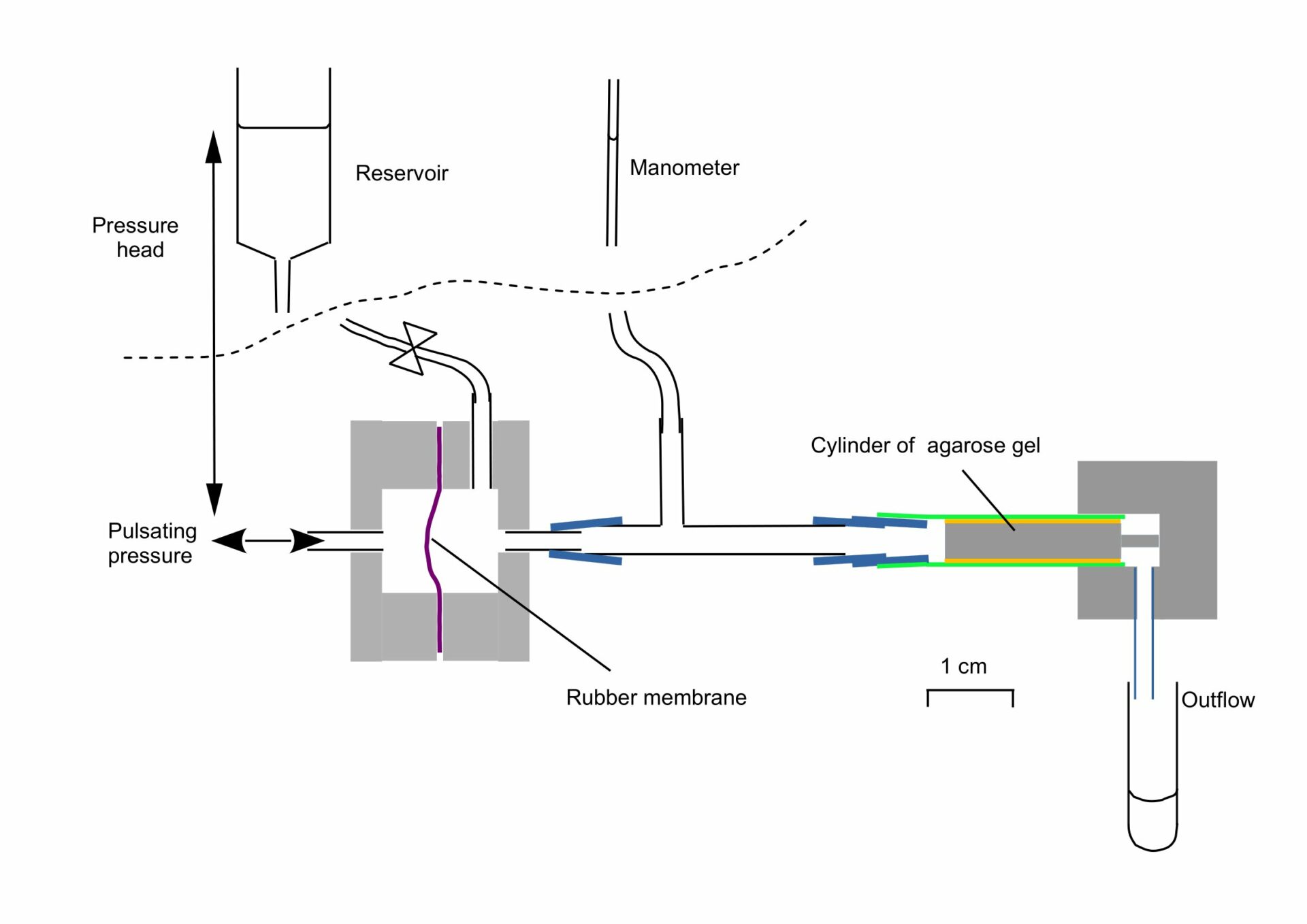Cerebrospinal fluid (CSF) delivers molecules to the vicinity of brain cells and may carry away others, such as amyloid-beta. In the cortex, CSF flows down peri-arteriolar space: its subsequent pathway is uncertain (see Hladky & Barrand, 2022). Protein marker molecules in CSF are observed to accumulate in the pericapillary basement membranes of brain capillaries (e.g., Rennels et al. 1985; Fig. 3C in Iliff et al. 2012) but it is improbable that a constant physiological pressure gradient could drive adequate CSF along a pericapillary pathway. The accumulation is slower if blood pulsation is reduced (e.g., Rennels et al. 1985). We have found only one publication on the effect of experimental pressure pulsation on transport through a porous medium of any kind: McMaster and Parsons (1938) on the movement of Evans Blue through rabbit ear tissue. We asked if a pulsating pressure could substantially increase fluid flow through a hydrogel mimicking basement membrane. We constructed a chamber with a central rod 20 mm long and 4 mm in diameter inside a silicone rubber tube i.d. 5 mm, wall thickness 0.5 mm (Fig. 1). This was filled with agarose gel 1% in NaCl 0.15M. A raised reservoir of 0.15M NaCl provided a static pressure of 20, 30 or 60 cm H2O. Flow was measured by weighing the efflux and care was taken to avoid menisci in the circuit. As described for other porous media, the flow was not proportional to the pressure gradient: when pressure was increased from 30 to 60 cm H2O, flow increased by a factor of 2.92 (SEM = 0.13, n = 17 tests), significantly more than 2 (P<0.0001, two-tailed t-test). The pressure could be modulated (without changing the mean pressure) by changing the air pressure applied to the external face of a rubber membrane bounding the vestibule upstream of the gel. The flow Q during a period of pulsation (lasting typically 15 – 40 min) was divided by the mean of the flows before and after to give the ratio Q(pulsation)/Q(no pulsation). With pressure heads of 20, 30 or 60 cm H2O, pulsation at 3 Hz with an amplitude of no more than 5.5% increased the flow (two-tailed t-test, P< 0.001, n > 30). With a pressure head of 20 cm and pulsation of 5.5% the increase (P = 0.018) was by a factor of 1.39, SEM = 0.10, n = 5. This increase is much smaller than that described by Hale & Coles (2022): we suggest that in those experiments the main effect of pulsation occurred at the menisci of the bubble used to measure flow along a polyethylene microburette, and not in the gel itself. The effect now reported seems too small to account for physiological transport of CSF along capillary basement membrane. However, if the dimensions were scaled down to those of a real capillary, and an optimum hydrogel were used, there might be a bigger effect.
Physiology 2023 (Harrogate, UK) (2023) Proc Physiol Soc 54, PCA087
Poster Communications: Pulsating pressure enhances transport of fluid through a macromolecular matrix: support for a flow of cerebrospinal fluid along the basement membranes of brain capillaries.
Jonathan Coles1, Michael Hale1,
1School of Infection and Immunity, College of Medical, Veterinary & Life Sciences, University of Glasgow,. Glasgow United Kingdom, 2School of Infection and Immunity, College of Medical, Veterinary & Life Sciences, University of Glasgow. Glasgow United Kingdom, 3School of Physical Sciences, The Open University, Walton Hall Milton Keynes MK7 6AA United Kingdom,
View other abstracts by:
Where applicable, experiments conform with Society ethical requirements.

